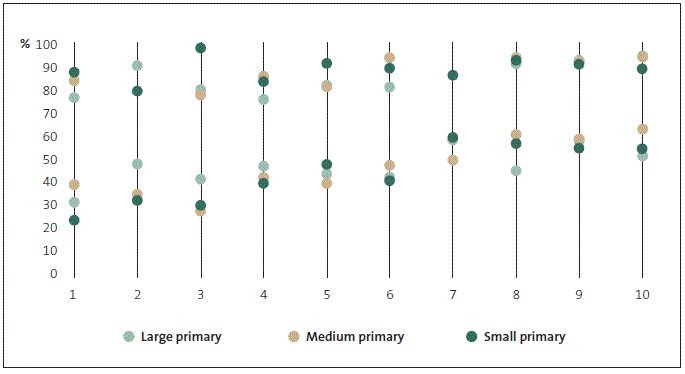Part 3: Schools prove it can be done – great opportunity for all schools to improve Māori educational success
3.1
Our analysis of National Standards and NCEA data for Māori students shows that some schools are able to achieve much better results in similar circumstances. This presents a significant learning opportunity to achieve better overall results for Māori students.
Māori students are likely to attend schools with challenging environments and settings
3.2
The school a student attends can have an effect on their achievement. The distribution of Māori students throughout the school system presents challenges to raising achievement. This is because, typically, many Māori students:
- attend schools where they form a small proportion of the total roll, which can make giving attention to Māori students and their whānau, and raising these students' achievements more of a challenge;
- attend small schools that are more likely to have fewer overall resources and where responsibility is placed on fewer teaching staff to achieve improved results; and
- attend low-decile schools that are more likely to have greater challenges and fewer community resources.
Opportunity for schools to learn from "similar" but better-performing schools
3.3
Figures 3 and 4 show that Māori students in schools with roughly similar3 settings and communities can achieve very different academic results. For example, in Figure 3, the achievement rate for the best-performing decile 1 small secondary school is almost three times better than the poorest-performing decile 1 small secondary school. This shows that some schools are able to achieve more in similar circumstances. Poorer-performing schools could learn from "similar" but better-performing schools.
3.4
In our view, addressing this variation in educational success is an opportunity to improve achievement results for all Māori students, who should all have the same opportunities to succeed, regardless of the school they attend.
Figure 3
Range of highest to lowest results for NCEA Level 2 for Māori students, by school size and decile, 2014

Source: Our analysis of the Ministry of Education's NCEA data.
Note 1: This excludes schools with fewer than 30 Māori students.
Note 2: In some instances, there was only one school of a particular type in our analysis. For example, there is only one large decile 1 secondary school in Figure 3. In those instances, there is only one dot, representing both highest and lowest.
Figure 4
Range of highest and lowest results for National Standards (average of reading, writing, and mathematics) for Māori students, by school size and decile, 2014

Source: Our analysis of the Ministry of Education's National Standards data. Note 1: This excludes schools with fewer than 30 Māori students.
Educational success as Māori is more than academic achievement
… success (for Māori) is not derived from simply teaching students the content of a curriculum or satisfying the requirements of a national assessment unit. We saw success as "mana-tangata" or "person-making" ...4
3.5
New Zealand needs educated, technically capable, and civic-minded citizens. It is important for our society and future prosperity that our citizens are confident, socially minded, and grounded in their language, culture, and identity.
3.6
Measuring "success as Māori" is an important element of Ka Hikitia and for creating future prosperity. However, it is not easy to measure, and we saw schools struggling to apply the strategy.
3.7
It is important to recognise that Māori student voices are an important source of information about what helps them to succeed. At a system level, we are aware of past and current research between the Ministry of Education and the New Zealand Council for Educational Research to include student voices as part of a study of student well-being. At an individual school level, we noted in our 2016 report about using information to improve Māori educational success that better-performing schools use student feedback to inform planning and assess how the school is meeting the students' needs.
3.8
For example, a kura we visited in the Waikato region pays special attention to its relationships with students, whānau, and the community. This provides those groups with a strong voice in the direction of the school, and the school with a range of information that contributes to the school's good results for Māori students. As the Education Review Office noted in its 2013 report about this school:
There is a well-established tripartite partnership between students, kaimahi5 and whānau who work effectively together to ensure that individual student needs and passions are well catered for. Partnerships with the wider community are strong. These contribute to the development of student's learning pathways. Students have work experience related to their chosen career pathway and are mentored with experts in their chosen field ...
3.9
Many of the Māori students we met knew what good teaching meant for them and what they needed. They had good knowledge about their own progress and how their teachers and their families could and should support them. The students we talked to were optimistic about the future and were proud to be Māori. Almost all believed that Māori cultural needs were valued in their school as an important part of their learning.
3: We have statistically controlled for decile, size of school, and type of school, so that the resulting groups can be referred to as similar. There are many other aspects other than decile, size of school roll, and school type that could also be used to describe groups of schools as similar.
4: Controller and Auditor-General (2013), Education for Māori: Implementing Ka Hikitia – Managing for Success, page 3.
5: Kaimahi means staff.

